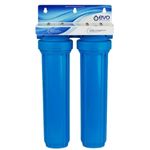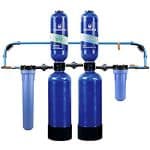Picking a whole house filter isn’t about fancy specs — it’s about whether the thing actually holds up once it’s on your line. That’s why we stuck with systems that showed solid test data and don’t turn into a maintenance project.
Bottom line: these are filters you can put in, forget about most days, and still get clean water and steady pressure without the drama..
📊 How We Test & Score

Whole house systems face very different challenges depending on whether they’re used on city water or well water. That’s why we score them separately. We balance Tap Score lab testing, NSF/ANSI certifications, and long-term use insights..
- City Water: Filtration Performance (45%), Flow / Pressure (20%), Build Quality (10%), Install & Maintenance (10%), Taste & Odor (5%), Certifications & Transparency (5%), Operating Cost (5%).
- Well Water: Target-Contaminant Performance (50%), Flow / Pressure (15%), Build Quality (10%), Install & Maintenance (10%), Taste & Odor (5%), Certifications & Transparency (5%), Operating Cost (5%).
🎯 How We Chose
Whole-house filters are judged by the same criteria used by the NSF, WQA, and IAPMO when certifying systems. We start with those baseline standards, then layer in our own lab testing and real-world ownership insights.
- Balanced results, not one-trick wins. Systems had to perform across contaminant removal, flow stability, build quality, and upkeep—not just shine in one category.
- Verified performance. Preference to models with published Tap Score or third-party lab reports, plus NSF/ANSI certifications relevant to POE filtration:
- 42 – chlorine, taste & odor
- 53 – health contaminants (when cartridge-based)
- 55 – UV disinfection (Class A/B)
- 61 – system component/material safety
- 372 – lead-free compliance
- Pressure that holds up. Filters must maintain whole-home flow (multi-tap, showers, laundry) at rated GPM with no bottlenecks.
- Ownership & maintenance. Clean install path (bypass, drains for backwash tanks), predictable filter/media lifespan, and reasonable annual cost.
- Build quality & parts. Durable tanks, valves, and fittings that meet IAPMO and WQA material standards; bonus points for included bypass valves.
- Transparent support. Fair warranties and responsive customer service. Systems that are a hassle to return or service didn’t make the cut.
- Real-world signals. We scan user feedback for recurring issues (pressure loss, leaks, short media life) and drop models with repeat problems.
👉 If a filter missed on any of these, it didn’t make our top list—because whole-house systems need to be more than just “good on paper.”
🔎 Expert Picks
- SpringWell CF1 — Best for municipal tap water
- Kind E-1000 — Best cartridge-based system
- Aquasana EQ-1000 — Best all-around filter
- iSpring WGB32B — Best budget 3-stage system
- SpringWell WS — Best for well water
- SoftPro Chlorine & Fluoride Filter — Best for targeted contaminants
#1. SpringWell CF
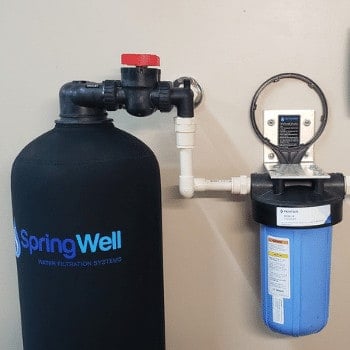
Scoring basis
- Filtration (45%): Score: 5/5 — Carbon + KDF media
- chlorine & THMs cut to non-detect in Tap Score testing
- Flow/Pressure (20%): Score: 5/5 — Steady multi-tap performance
- holds strong at 9–20 GPM depending on setup
- Install/Maint (10%): Score: 4/5 — Clean install
- sediment filter swaps every 8–9 months on our system
- Build (10%): Score: 4.5/5 — Solid tank and hardware
- runs silently once in place
- Taste (5%) — Score: 5/5
- Cost (5%) — Score: 5/5
- Certs (5%) — Score: 4/5
We tested our water in 2022 before installing the SpringWell CF1 and again in 2025 after more than 3 years of use.
Both Tap Score reports confirmed chlorine byproducts (THMs) were cut from 31.8 ppb to non-detect — a 100% reduction.
Why We Like It
- Showers feel less dry once chlorine’s gone
- Low-touch upkeep — no cartridges to babysit
- Water pressure still strong after 3+ years
- Runs silently once installed
- Lifetime warranty adds confidence for the long haul
What Could Be Better
- Tall tank is bulky in tight spaces
- No reminder for sediment swaps — we replace every ~8–9 months
Use Coupon Code: QWL5 to Save!
Best for: City water households needing whole-home chlorine, chloramine, VOC, and PFAS reduction.
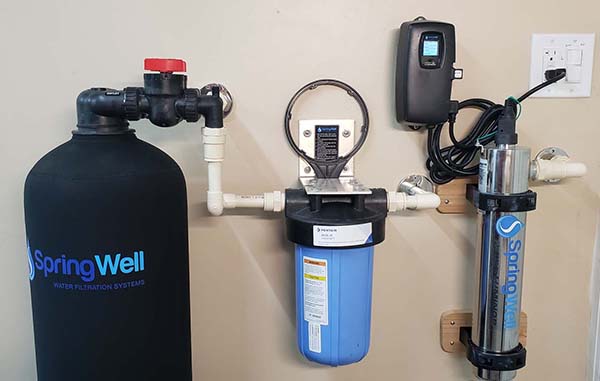
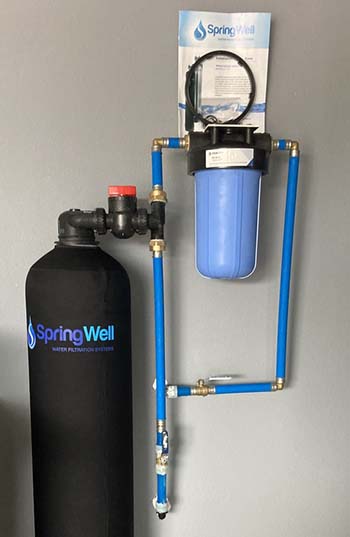
🔬 Tap Score Lab Results — 2022 Baseline vs. 2025 Post-Install
| Parameter | Before | After | Change |
|---|---|---|---|
| Total THMs iEPA MCL: 80 ppb | 31.83 ppb | NDRemoved | −100% |
| Chloroform (THM) | 21.57 ppb | NDRemoved | −100% |
| Bromodichloromethane | 7.93 ppb | NDRemoved | −100% |
| Dibromochloromethane | 2.33 ppb | NDRemoved | −100% |
| Lead iEPA action level: 15 ppb | ND | 0.5 ppbTrace* | Trace |
| Copper iEPA action level: 1300 ppb | 20 ppb | 35 ppb | +15 ppb |
| Barium iEPA MCL: 2000 ppb | 10 ppb | 12 ppb | +2 ppb |
| Zinc | 160 ppb | 159 ppb | ≈ same |
| Iron | 10 ppb | NDRemoved | −100% |
| Total Dissolved Solids (TDS) iMineral content; not a performance target for carbon filters | 187 ppm | 280 ppm | Source variation* |
Context & Methods
“ND” = Not Detected above the lab reporting limit. THMs compared to EPA MCL (80 ppb). Barium compared to EPA MCL (2 ppm). Samples analyzed by Tap Score (ETR Labs & Microbac).
*Lead note: A trace detection at 0.5 ppb (~30× lower than EPA’s 15 ppb action level) was traced to a leaking kitchen faucet with failing braided supply lines. The fixture was replaced after sampling. The SpringWell CF does not add lead.
*TDS note: TDS reflects natural mineral content in city water and can vary seasonally and year-to-year. The SpringWell CF is not designed to reduce TDS. Differences between 2022 (baseline) and 2025 (post-test) reflect supply variation, not filter performance.
Pre-test (before SpringWell CF):
View baseline report (PDF)
Post-test (after SpringWell CF):
View post-test report (PDF)
🧾 How SpringWell CF Scored
Tap Score testing showed the CF eliminated chlorine byproducts (THMs) from 31.8 ppb down to non-detect — and it held that result after more than three years of daily use, which is rare for a tank-based system. Few whole house filters can point to verified long-term performance at this scale.
On the ownership side, the CF is practically invisible once installed — no noise, no pressure loss, and no cartridge juggling. The only upkeep has been sediment swaps every 8–9 months at about $40 a year, making it far cheaper to run than cartridge systems that often chew through $200–$400 in filters annually.
It’s not a “smart” system out of the box, but app connectivity is available with the optional smart shutoff add-on, which provides leak detection and water monitoring — a useful layer of insurance for city households.
What stood out in practice is the stability: showers stay pressurized, chlorine odor never creeps back in, and the tank media hasn’t shown performance drift over time. You’ll need adequate vertical clearance and an initial soak/flush, but once that’s done it’s essentially hands-off.
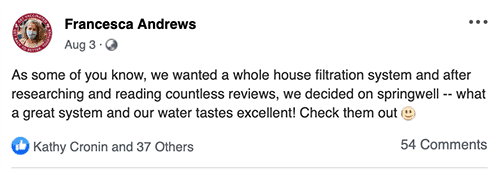
🛠 Product Options & Upgrades
- Models for any home size: CF1 (1–3 baths, 9 GPM), CF4 (4–6 baths, 12 GPM), and CF+ (7+ baths, up to 20 GPM). Flow stayed steady in our 3-year test, even under multi-tap demand.
- Contaminant coverage beyond chlorine: Catalytic carbon + KDF media blend reduces chloramine, VOCs, pesticides, and PFAS. Tap Score confirmed chlorine byproducts dropped to non-detect; we’ll validate additional categories in upcoming lab rounds.
- DIY-friendly install: Expect ~2–3 hours with basic plumbing skills. A carbon soak/flush is required, but Clack-style quick connectors (sold separately) can simplify setup.
- Optional add-ons: UV purification for boil-water advisories, and a smart shutoff monitor for leak detection and flood protection.
Bottom line: If you want a lab-verified system that keeps pressure steady and costs pennies a day to maintain, the SpringWell CF is one of the most proven long-term buys for city water.
Use Coupon Code: QWL5 to Save!
Read our Full Review: Springwell Whole House Filter Review
#2. Kind E-1000
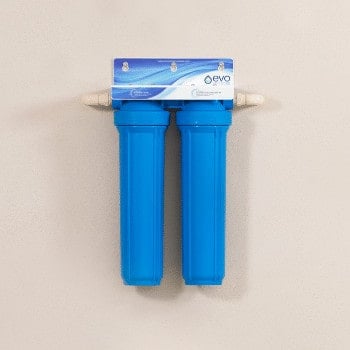
Scoring basis
- Filtration (45%): Score: 4/5 - Dual-cartridge carbon system
- NSF/ANSI 42 components
- Flow/Pressure (20%): Score: 5/5 - Rated 15 GPM
- holds pressure for medium-large homes
- Install/Maint (10%): Score: 4/5 - DIY-friendly
- more frequent swaps with heavy use
- Build (10%): Score: 4/5 - Compact twin canisters
- sturdy hardware
- Taste (5%): 4.5/5
- Cost (5%): 3.5/5
- Certs (5%): 4/5
If you like what SpringWell offers but need something more affordable, the Kind E-1000 might be the better fit.
It’s about a third less up front, still takes out chlorine, chloramine, and VOCs—and the water quality is noticeably cleaner than straight-from-the-tap municipal.
The only real tradeoff? You’ll likely change filters more often, especially if your household uses a lot of water.
What we like:
- Washable 5-micron sediment filter — reusable multiple times, unlike standard throwaway cartridges.
- Catalytic carbon block — tackles chlorine, chloramine, VOCs, and disinfection byproducts without shedding carbon dust.
- 15 GPM flow rate — enough for homes with 3–5 bathrooms, no drop during multi-shower use.
- Low install barrier — no drain or power needed; connects with two fittings.
- Compact design — slimmer footprint than tank filters, easier wall-mount in tight utility spaces.
What Could Be Better
- Cartridge costs add up — yearly carbon replacements run $150–$300 depending on water use.
- No monitoring system — no app, gauge, or smart alerts; lifespan tracking is manual.
- Single model option — capped at 15 GPM; larger households need the Kind-3000 upgrade.
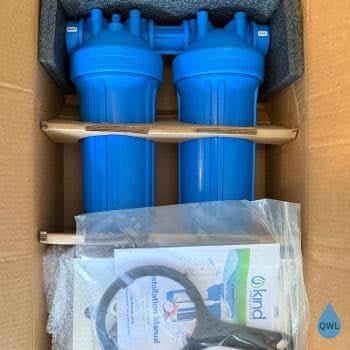
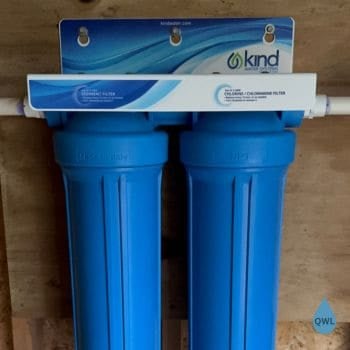
🔬 Tap Score Lab Results
| Parameter | Before | After | Change |
|---|---|---|---|
| Total THMs iEPA MCL: 80 ppb | 31.83 ppb | NDRemoved | −100% |
| Chloroform (THM) | 21.57 ppb | NDRemoved | −100% |
| Bromodichloromethane | 7.93 ppb | NDRemoved | −100% |
| Dibromochloromethane | 2.33 ppb | NDRemoved | −100% |
| Turbidity iEPA SMCL: 1 NTU | 0.8 NTU | 0.1 NTUReduced | −88% |
| Iron | 10 ppb | NDRemoved | −100% |
| Copper iEPA action level: 1300 ppb | 20 ppb | 2 ppbReduced | −90% |
| Barium iEPA MCL: 2000 ppb | 10 ppb | 15 ppb | +5 ppb |
| Total Dissolved Solids (TDS) iMineral content; not a performance target for carbon filters | 187 ppm | 275 ppm | +88 ppm |
Context & Methods
“ND” = Not Detected above the lab reporting limit. THMs compared to EPA MCL (80 ppb). Turbidity compared to EPA SMCL (1 NTU). Samples analyzed by Tap Score (ETR Labs & Microbac).
*Note: Kind’s pleated sediment filter is washable and can be reused several times before replacement, which may extend life in heavy-sediment areas. Performance above reflects standard use conditions.
Baseline (Advanced City Test):
View baseline report (PDF)
Post-test (after filtration with Kind E-1000):
View post-install report (PDF)
Overall Tap Score improvement: 77/99 → 83/99
🧾 How Kind E-1000 Scored
Kind holds a steady 15 GPM — rare for a cartridge setup. The carbon stage is rated for 80K gallons, with most homes getting close to a year per swap. The washable 5-micron prefilter stretches life further, keeping upkeep around $150–$200/yr.
It runs simpler than a tank system: twist-off housings, no drain or power, with changes done in minutes. Downsides are width on the wall and snug housings — keep the strap/spanner wrench close.
It’s not NSF-certified as a whole unit like the Aquasana EQ-1000, but the components are NSF/ANSI 42, 61, and 372 tested and CSA B483.1 compliant, so materials are proven safe for drinking water.
Best for city water where chlorine and byproducts are the main issue. For fluoride or PFAS, pair with an under-sink RO.
Bottom line: A lower-cost alternative to tank systems that still delivers steady flow and cleaner water — if you don’t mind annual cartridge swaps.
Read our full review: Kind-E 1000 Whole house water filter review
#3. Aquasana EQ-1000
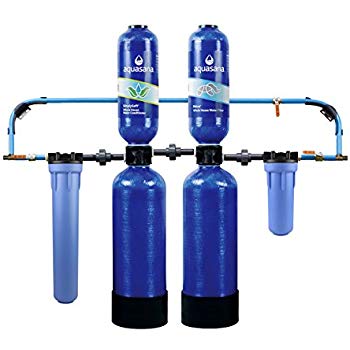
Scoring basis
- Filtration (45%): Score: 4.5/5 - NSF/ANSI 42 tested for chlorine
- tank certified NSF/ANSI 61
- Flow/Pressure (20%): Score: 4/5 - Rated 12 GPM
- steady for most homes
- Install/Maint (10%): Score: 4/5 - Multi-stage setup
- pre/post filters every 3–6 months
- Build (10%): Score: 4.5/5 - Large tank
- proven 1,000,000-gallon capacity
- Taste (5%): 4/5
- Cost (5%): 4/5
- Certs (5%): 4.5/5
If you want cleaner, better-tasting water and some help with hard water scale — without the hassle of salt — the Aquasana EQ-1000 is a strong all-in-one option.
It filters chlorine, VOCs, and industrial runoff while conditioning water using a salt-free (TAC) process. No brine tanks, no electricity, and almost zero maintenance beyond routine filter changes.
Why We Like It
- NSF/ANSI 42 tested for chlorine reduction (up to 97%)
- Tank certified to NSF/ANSI 61 for material safety
- Built-in TAC media reduces scale without salt or power
- Reliable 12 GPM flow — steady in most mid-sized homes
- Bacteriostatic KDF layer helps keep the tank media fresher, longer
What Could Be Better
- Pre-filters clog fast — often need swaps every 2–3 months
- Warranty only stretches to 10 years with pro install (1 year DIY)
- No bypass included — adds extra cost/time at setup
Use Coupon Code: AQQWL50 to Save!
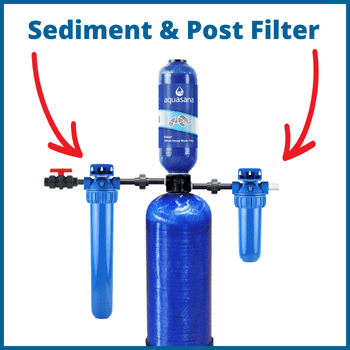
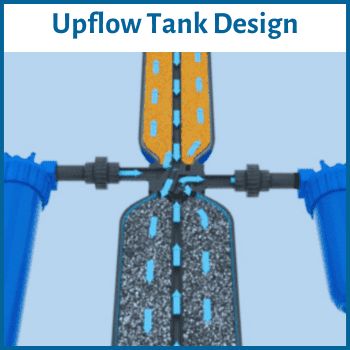
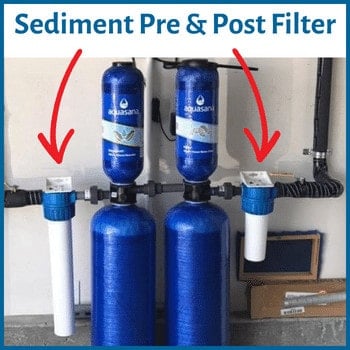
🧾 How Aquasana EQ-1000 Scored
In our research, the EQ-1000 does what it promises: chlorine taste and odor drop noticeably, and the KDF stage helps keep the tank from growing anything funky over time. The salt-free TAC stage is harder to measure — there’s no lab test for “scale prevention” — but fixtures and glassware do stay cleaner when it’s in play.
On the maintenance side, the 1M-gallon tank runs for years, but the pre-filter needs swapping every few months, especially in areas with heavy sediment. That’s a bigger chore than with a tank-only system like SpringWell, though still cheaper than buying cartridge filters all year.
Warranty coverage is also tied to installation: 10 years if you hire a pro, just 1 year if you DIY. That’s something to weigh if you’re planning to handle setup yourself.
Bottom line: If you want whole-home chlorine reduction with some scale control baked in — and you don’t mind regular pre-filter swaps — the EQ-1000 is one of the more versatile options, especially for households that want filtration and conditioning in a single system.
Read our Full Review: Aquasana EQ-1000 Review
#4. iSpring WGB32B

Scoring basis
- Filtration (45%): Score: 4.5/5 — Triple-stage with NSF/ANSI compliant sediment + carbon filters for chlorine/sediment
- Flow/Pressure (20%): Score: 4.5/5 — Rated 15 GPM
- keeps pace with medium–large households
- Install/Maint (10%): Score: 4/5 — DIY-friendly install
- cartridges last ~100k gallons
- Build (10%): Score: 4/5 — Solid housings
- straightforward cartridge swaps
- Taste (5%): 4/5
- Cost (5%): 5/5
- Certs (5%): 4/5
iSpring WGB32B — a 3-stage cartridge system that filters chlorine, sediment, and light iron/manganese at a lower upfront cost than tank systems.
Its NSF/ANSI compliant filters give component-level assurance, though it lacks full system certification.
Compared to tank units like SpringWell CF1, it’s easier to DIY and cheaper up front, but cartridges add ongoing costs.
What we like
- NSF/ANSI compliant filters for chlorine and sediment reduction
- Strong 15 GPM flow supports larger households without pressure loss
- Upfront cost is less than half of tank systems like SpringWell CF1
- DIY installation with included bracket, wrench, and fittings
What we don’t
- No full system NSF certification (only components)
- Cartridges need replacement every 6–12 months (~$200/year)
- Short 1-year warranty compared to lifetime coverage from peers
Best for: Households that want affordable, cartridge-based chlorine and sediment protection without the upfront cost of a tank filter.
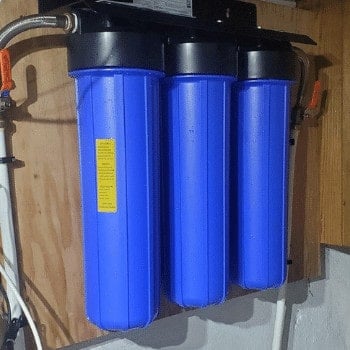
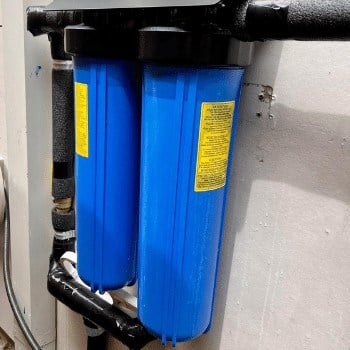
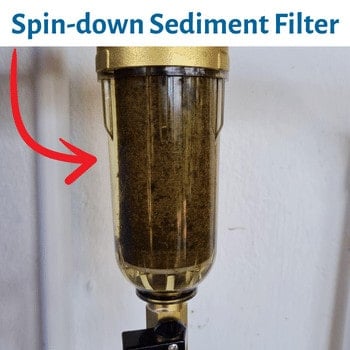
🧾 How it Scored
Performance: The WGB32B does the basics well: chlorine taste and odor drop noticeably, and the FM25B filter cuts staining and metallic taste from low-level iron and manganese — a rare combo at this price point. Its NSF/ANSI compliant cartridges add credibility, though the unit isn’t certified as a full system like Aquasana EQ-1000.
Daily Use: Flow is solid at 15 GPM — strong enough for multi-shower use without a drop, on par with Kind E-1000. The clear sediment housing is handy for quick visual checks, and cartridge swaps are straightforward with the included wrench. Build feels sturdy for the price, though the unit is bulky on a wall compared to tank systems.
Costs & Longevity: Upfront cost (~$420) is budget-friendly, but replacement filters add $180–$250/year depending on water quality. Cartridges last up to 100,000 gallons, but heavy sediment or iron can shorten that. Over a 5-year span, it costs more to maintain than tank systems like SpringWell CF1, but still beats premium cartridge systems on per-gallon cost.
Trade-offs: No bypass or shutoff is built in, so installation planning matters. The 1-year warranty is short compared to lifetime coverage from peers. And while it helps with light iron, it’s not meant for sulfur, bacteria, or aggressive well water.
Bottom Line: The iSpring WGB32B delivers solid chlorine and sediment reduction with budget-friendly entry costs and DIY convenience. Best for city or light-well households that want straightforward protection and don’t mind yearly cartridge changes.
Ispring 3-stage Product Updates:
- Ispring now comes with CTO carbon block filters for enhanced water quality
Read our full review: Ispring 3-stage Review
#5. SpringWell WS
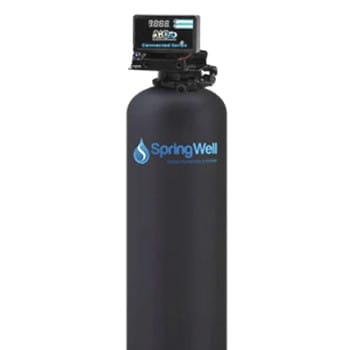
Scoring basis
- Filtration (50%): Score: 5/5 — Air injection + catalytic media eliminates iron, manganese, and rotten-egg sulfur odor
- Flow/Pressure (20%): Score: 5/5 — Rated 12–20 GPM
- keeps up with multi-bathroom, high-demand households
- Install/Maint (15%): Score: 4.5/5 — Needs drain + power for backwash
- Bluetooth valve makes monitoring easy
- Build (10%): Score: 5/5 — Heavy-duty tank and control head built for 8–10 years of media life
- Cost (3%) — Score: 5/5
- Certs (2%) — Score: 3.5/5
SpringWell WS — a chemical-free oxidizing filter that clears iron, sulfur, and manganese from well water.
Unlike cartridge systems that clog fast, the WS keeps pressure steady and regenerates automatically.
Compared to the SoftPro Iron Master, it’s easier to manage day-to-day, though not built for extreme iron levels above 7–8 ppm.
What We Like
- Chemical-free air injection + catalytic media — no chlorine or potassium permanganate needed
- Strong 12–20 GPM flow — no pressure loss even in multi-bathroom homes
- Bluetooth app — makes backwash scheduling and monitoring simple
- Lifetime warranty and 8–10 year media life — reliable for long-term well use
- Quiet daily operation; no cartridge swaps or ongoing filter costs
What Could Be Better
- Needs a drain and power connection for backwash setup
- Not ideal for extreme iron (>8 ppm) — SoftPro Iron Master is better suited there
Best for: well water households battling sulfur odor, staining, and metallic taste that want a low-maintenance, chemical-free solution.
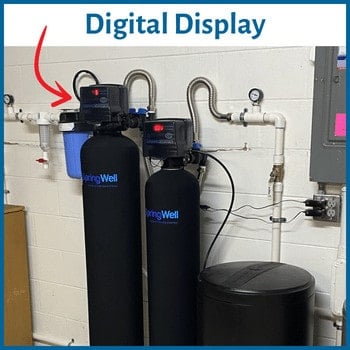


🧾 How it Scored
We’ve already put SpringWell’s carbon filter (CF1) through Tap Score testing, where chlorine byproducts dropped from 31.8 ppb to non-detect even after three years of use. While that test wasn’t on the WS specifically, it does give some confidence in the brand’s media quality.
The WS isn’t built for chlorine — it’s an air-injection oxidizer that goes after iron, manganese, and sulfur. In the field, it can handle up to about 7 ppm of iron, 1 ppm manganese, and 8 ppm sulfur without the usual headaches of chemicals or cartridge swaps.
When you line it up against the SoftPro Iron Master, the tradeoff is pretty clear: the WS is easier to live with (automatic backwash, Bluetooth app), while the Iron Master is the stronger choice if your water has extreme iron above 8–10 ppm.
Upkeep is close to nothing once it’s running. Beyond a little backwash water and checking the app once in a while, there’s not much to it. That’s a big contrast to cartridge systems that can easily run $200–$400 a year in replacements.
Bottom line: The WS is one of the easier whole-house fixes for smelly or metallic well water. It doesn’t try to be a catch-all system, but for iron and sulfur in the typical range, it’s a dependable, set-and-forget option.

Use Coupon Code: QWL5 to save
SpringWell WS Product Updates:
- SpringWell now offer filtration for 4+ bathrooms
- Optional UV add-on that can eliminate nearly 100% of harmful viruses.
- Optional Reverse osmosis upgrade
Read our full review: Springwell WS1 Review
#6. SoftPro Chlorine & Fluoride Filter

Scoring basis
- Filtration (45%): Score: 4.5/5 — Catalytic carbon + bone char media targets fluoride, chlorine, and chloramine reduction
- Flow/Pressure (20%): Score: 4/5 — Rated 10–14 GPM
- best suited for small to mid-size households
- Install/Maint (10%): Score: 5/5 — Non-electric, straightforward setup with minimal upkeep
- Build (10%): Score: 4.5/5 — Solid upflow tank design
- operates passively without power
- Taste (5%) — Score: 4.5/5
- Cost (5%) — Score: 5/5
- Certs (5%) — Score: 4/5
If fluoride tops your worry list, the SoftPro Chlorine + Fluoride Filter covers a rare gap most carbon-only systems miss. Its blend of catalytic carbon and bone char is designed to cut fluoride, chlorine, and chloramine at the whole-house level — without sacrificing flow or adding upkeep.
Compared to tank filters like the SpringWell CF1, SoftPro trades some flow capacity for a more targeted focus: fluoride removal at scale, something very few competitors attempt.
What We Like
- Whole-house fluoride reduction — rare outside RO.
- Catalytic carbon + bone char tackle chlorine and VOCs.
- NSF 61 certified tank materials.
- Runs passively — no power or backwash needed.
- Cheap upkeep (~$20–$40/year pre-filter swaps).
What Could Be Better
- Flow tops at 10–14 GPM, fine for small to mid-size homes.
- No fluoride-specific NSF cert — relies on media claims.
- Tall tank needs vertical clearance.
Best for: City water households that want whole-home fluoride reduction without complex upkeep or high costs.
🧾 How it Scored
SoftPro’s tank uses a dual-media blend of catalytic carbon and bone char, giving it one of the few whole-home options that actually targets fluoride. Independent NSF 61 certification backs the tank materials, though fluoride performance is based on media claims rather than a dedicated NSF reduction test.
In practice, the system shines for chlorine and chloramine reduction — with many owners reporting cleaner taste, fewer odors in tap water and shower steam. Flow rates stay strong at 10–14 GPM — enough for most small to mid-sized households — and upkeep is limited to a low-cost sediment prefilter swap once or twice a year.
Where it falls short is proof: unlike SpringWell’s CF1, which we lab-tested and confirmed against THMs, SoftPro hasn’t been independently verified for whole-house fluoride removal. Performance also tapers as the media ages, meaning replacement intervals can vary based on water chemistry.
Costs are a win. Annual upkeep runs just $20–$40 in prefilter changes, far cheaper than cartridge systems that can chew through $200–$300 a year.
Bottom line: The SoftPro Chlorine + Fluoride Filter delivers rare whole-home fluoride reduction in a simple, low-maintenance tank. Best for city water households that want fluoride coverage without stepping up to reverse osmosis.
Didn’t find what you’re looking for? See our other whole house water filter reviews:
🛒 Buyer’s Guide
Buying a whole house water filter doesn’t have to be overwhelming or overpriced. The key is matching the right system to your water quality, plumbing setup, and long-term goals — not just grabbing what’s popular.
We created this guide to take the guesswork out of it.
You’ll learn:
- 🧪 How to test your water and match systems to your actual risks
- 💡 Which features matter most for your home’s size, water source, and layout
- 📏 Key sizing, flow rate, and media differences (tank vs cartridge, and more)
- 🔧 What to expect from installation — DIY vs pro, plumbing tweaks, and prep
- 🔁 How to maintain it long-term without surprise costs
- ⚠️ Where most people go wrong (and how to avoid expensive mistakes)
Plus: We’ll walk you through a few bonus tips most brands and comparison sites skip — including a pre-install checklist and what hidden costs to look out for.
🧾 Certifications
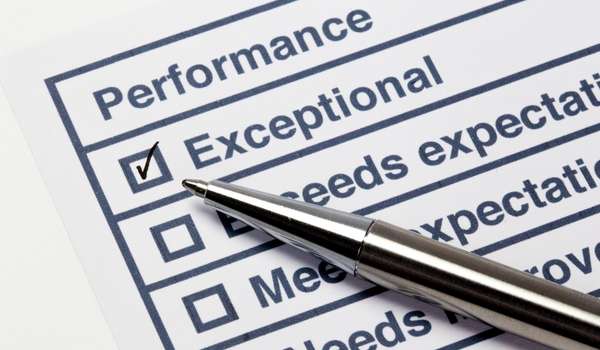
Choosing a system isn’t just about price or popularity — it’s about what actually fits your water, plumbing, and usage. Here’s what to consider before you commit:
- 🧪 Contaminant Removal Look for systems with independent performance data or lab-certified results against the specific risks in your water — especially PFAS, chlorine, lead, VOCs, or sediment. Pay attention to micron ratings, media type, and third-party certifications like NSF/ANSI.
- 💧 Flow Rate Make sure your water pressure doesn’t take a hit. A good whole house filter should maintain flow even in larger homes. Aim for a rated flow of 7 GPM or higher for families with multiple bathrooms.
- 🔧 Ease of Installation Systems vary in how user-friendly they are. Some install in under an hour with basic tools. Others need pro-level plumbing. Know what your setup can handle before you buy.
- 🔁 Filter Replacement & Maintenance Some filters need changing every 6–12 months, while others last 5+ years. Understand the ongoing time and cost involved — and avoid systems that require frequent attention or special tools.
- 📋 Certifications That Actually Matter NSF/ANSI certifications aren’t just buzzwords — they help confirm whether a system performs as advertised. For example:
- NSF 42 = targets chlorine taste and odor
- NSF 53 = covers health-based contaminants like lead or cysts
- NSF 401 = includes PFAS, pharmaceuticals, and other emerging risks
- 🛡️ Warranty & Company Reputation A strong filter shouldn’t come with weak support. We prioritize companies that back their products with clear warranties, good return policies, and responsive service — so you’re not stuck if something goes wrong.
- 💲 Long-Term Costs Beyond upfront pricing, factor in:
- 🔁 Replacement filter frequency
- 💵 Ongoing cost of filter sets
- 🧰 Any accessories (bypass valves, UV, etc.) that may add to the price over time
🧪 Contaminant Reduction Capability
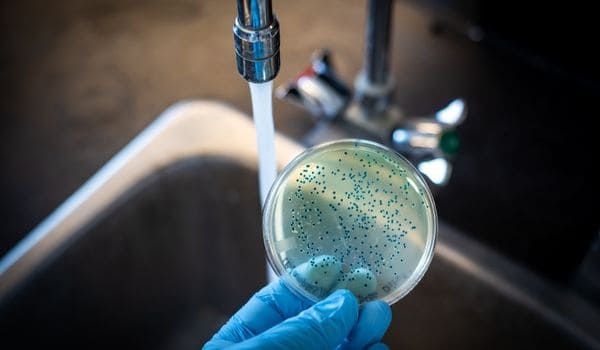
Whether you’re on city water or a private well, no two homes face the same threats. Lead from aging pipes, chlorine byproducts, PFAS, agricultural runoff, and even pharmaceutical traces are just the start. And while additives like fluoride and chloride are used for safety, they can pose long-term concerns depending on your health or filtration goals.
Hard water is another factor. Though not a health risk, excess minerals like calcium and magnesium can reduce the lifespan of your appliances, clog pipes, and interfere with soaps and detergents.
The key to choosing the right whole house filter? Know what you’re dealing with — and what you want to avoid.
🧠 Expert Insight: Most systems won’t remove everything. Filters are typically optimized for specific contaminant classes:
- Carbon targets chlorine, VOCs, pesticides, and odors
- Catalytic carbon is better for chloramine and some PFAS
- KDF or media blends help reduce metals like lead or iron
- UV or submicron filters are needed for microbes or cysts
🔬 Why a Water Test Is Non-Negotiable
Before spending thousands, get your water tested.
You don’t need to guess — or rely on marketing claims.
- City water? Request a report from your utility, then validate it with an at-home test kit.
- Well water? Test at least once per year — more often if you live near farms, industry, or septic systems.
| 💧 What Testing Can Reveal | 🔧 Why It Matters |
|---|---|
|
• Iron, manganese, hydrogen sulfide • Hardness, low pH, sediment • Chlorine, chloramine, lead • Bacteria, VOCs, PFAS |
• Prevents system mismatch • Helps you choose the right media • Flags urgent health risks • Saves you from installing the wrong setup |
Even a $30 DIY kit can flag major issues — but a certified lab test gives you the clearest picture of what you’re drinking.
💬 “The first time I tested my tap water, I expected mild chlorine. It came back over 3 ppm — no wonder my skin was so dry. That’s what pushed me to install a carbon filter right away.”
👉 See our top recommended water test kits.
📊 Capacity & Flow Rate: Why They Matter
- Capacity refers to how much water a system can treat before the filters need replacing. A larger capacity often means fewer filter changes and less long-term upkeep.
- Flow rate (GPM) indicates how quickly water moves through the system. If several taps or appliances are used at the same time, a system with too low a flow rate can cause drops in pressure.
🧠 Pro Tip: A flow rate of 6–7 GPM typically works for most households. For larger homes or higher demand, aim for systems rated at 10 GPM or higher.
| Brand | Capacity | Flow Rate |
|---|---|---|
| SpringWell CF | 1,000,000 gallons | Up to 20 GPM |
| Aquasana EQ-1000 | 1,000,000 gallons | 7 GPM |
| Kind E-1000 | 100,000 gallons | 15 GPM |
| iSpring WGB32BM | 100,000 gallons | 7 GPM |
| SpringWell WS | 1,000,000 gallons | Up to 20 GPM |
| SoftPro Chlorine+ & Fluoride | 600,000 gallons | 8 GPM |
💧 Typical Water Flow Rates by Fixture
To avoid pressure issues, it helps to understand how much water your household appliances use. Here’s a quick breakdown of average flow rates by common fixture:
| Fixtures & Appliances | Flow-rate (GPM) |
|---|---|
| Dishwasher | 1–3 GPM |
| Washing Machine | 3–5 GPM |
| Shower | 2–5 GPM |
| Toilet | 2–3 GPM |
| Faucet | 2–4 GPM |
Flow rate reflects how quickly water moves through your system. Most homes need around 6–7 GPM to support basic overlapping uses — like a shower and toilet running at once.
⚠️ Keep in mind: Filters with broader contaminant removal tend to have lower flow rates. For example, the Aquasana EQ-1000 prioritizes chemical reduction but tops out at 7 GPM, while the Kind E-1000 flows up to 15 GPM — better for higher water demand but with fewer filtration stages.
🧩 Determining Your Home’s Water Flow Rate
Before choosing a filtration system, it’s important to know how much water your household actually uses at once. This is known as your effective flow rate — and it plays a big role in selecting a filter that can keep up during peak demand.
Here’s a quick way to measure it:
- Make sure all indoor faucets are turned off.
- Take a 5-gallon bucket and place it under your outdoor spigot.
- Turn on the water and time how long it takes to fill the bucket.
- Use the chart below to estimate your system’s GPM.
💡 Example: If it takes 60 seconds to fill the bucket, your flow rate is roughly 5 GPM.
| Seconds To Fill 5 Gallon Bucket | Water Flow Rate | Seconds To Fill 5 Gallon Bucket | Water Flow Rate |
|---|---|---|---|
| 76–100 | 3 GPM | 61–75 | 4 GPM |
| 51–60 | 5 GPM | 43–50 | 6 GPM |
| 38–42 | 7 GPM | 34–37 | 8 GPM |
| 31–33 | 9 GPM | 28–30 | 10 GPM |
| 26–27 | 11 GPM | 24–25 | 12 GPM |
| 22–23 | 13 GPM | 21 | 14 GPM |
| 20 | 15 GPM | 19 | 16 GPM |
| 18 | 17 GPM | 17 | 18 GPM |
| 16 | 19 GPM | 15 | 20 GPM |
| 14 | 21 GPM | 13 | 22 GPM |
| 12 | 23 GPM | 11 | 24 GPM |
| 10 | 25 GPM |
💡 Pro Tip: Most of the filters featured above deliver between 7 and 20 GPM. If your household tests closer to the 10 GPM mark (or higher), you’ll want to avoid lower-capacity units — especially if you run multiple showers or appliances at once.
I’ve used this exact method myself — if your bucket fills in 20–30 seconds, you’re probably in the 10+ GPM range, which puts you in the clear for most whole house systems. But if it’s taking longer than 60 seconds, I start suspecting pressure or pipe restrictions.
🔬 Micron Ratings: Why They Matter
The micron rating tells you the smallest particle a filter can remove — and it’s one of the biggest factors in how effective your filtration system will be.
Most whole house filters range between 0.5 to 50 microns, depending on the target contaminants:
- ✅ 0.5–10 microns: Best for microscopic threats like bacteria, viruses, and fine sediment.
- 🪨 20–50 microns: Good for trapping large particles like sand, silt, and visible rust.
⚠️ Note: Lower micron ratings often reduce flow rate. That’s one reason whole house reverse osmosis systems are rarely used — they filter thoroughly but slow your water pressure dramatically.on why whole house reverse osmosis systems aren’t as prevalent in the market.
📋 NSF Certifications: What They Actually Mean
While the EPA doesn’t directly regulate water filters, NSF International and ANSI provide voluntary standards that most reputable systems follow.
Here are the most relevant NSF standards to look for:
| Certification | What It Covers | |
|---|---|---|
| NSF 42 | Improves taste and odor (chlorine, etc.) | |
| NSF 44 | Softens water using ion exchange | |
| NSF 53 | Removes contaminants known to affect health | |
| NSF 55 | UV light to neutralize bacteria, viruses, and cysts | |
| NSF 58 | Covers reverse osmosis systems regulated by EPA | |
| NSF 401 | Targets emerging compounds like PFOA and pharmaceuticals |
| Brand | Media Change / Replacement | Estimated Cost |
|---|---|---|
| SpringWell CF | 10 years or 1,000,000 gallons | $335 |
| Aquasana EQ-1000 | 10 years or 1,000,000 gallons (pre-filter: every 3 months) |
$849 |
| Kind E-1000 | 12 months (cartridges) | $298 |
| iSpring WGB32BM | 6–12 months (cartridges) | $149.99 |
| SpringWell WS | 10 years or 1,000,000 gallons | $410 |
| SoftPro Chlorine+ & Fluoride | 300,000 gallons or ~3–5 years | $465 |
💡 Expert Insight: When comparing filter costs, don’t just look at the upfront price — consider how often you’ll need to replace the media. A cheaper system with short filter cycles can cost more in the long run than a high-capacity tank with minimal upkeep.
💸 Understanding the Costs
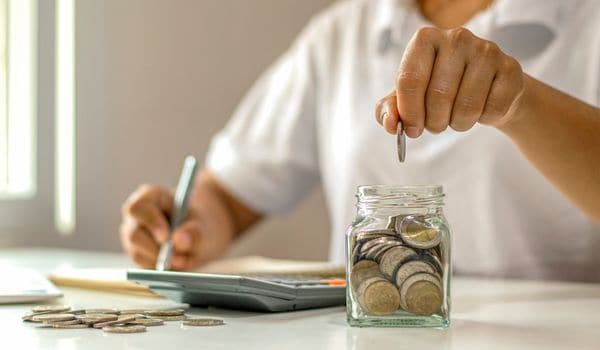
While the price tags on whole house water filters might seem steep at first glance, it’s the long-term cost that tells the real story. Lower-cost systems often require more frequent media changes or have shorter warranties, which adds up fast over time.
Think of it as total cost of ownership — not just the purchase price, but also how often you’ll be changing filters and what those replacements cost.
| System Type | Average Cost |
|---|---|
| Whole House Filtration System | $750 to $3,500+ |
| Well Water Filtration System | $750 to $3,500+ |
| Reverse Osmosis System | $500 to $8,000+ |
| UV Disinfection System | $600 to $1,200+ |
🧰 Professional Installation: What to Expect
Installation costs vary based on system type, home plumbing layout, and your region. Most licensed plumbers charge for a minimum of four hours, even if the install takes less time. If your setup requires extra piping, fittings, or a pre-filter bypass, expect that to increase the total.
| System Type | Labor | Average Installation Cost |
|---|---|---|
| Whole House Filtration System | 4 to 8 hours | $500 to $1,200+ |
| Well Filtration System | 4 to 8 hours | $500 to $1,200+ |
| Reverse Osmosis System | 4 to 8 hours | $500 to $1,200+ |
| UV Disinfection System | 4 hours or less | $350 to $600 |
For more insight into true pricing, visit our full guide: How Much Do Whole House Water Filter Systems Cost?
🔧 Pre-Installation Checklist
Before you pick up the phone to call a plumber, make sure your space and setup are ready. This quick list helps avoid surprises (and extra charges) on install day:
- 💧 Main Water Shut-Off Location: Know where it is and confirm it works.
- 📐 Adequate Space: Ensure at least 2–3 feet of clearance for tanks or cartridges.
- 📏 Pipe Size Compatibility: Most systems work with 1” pipe — adapters may be needed for ¾”.
- 🔌 Nearby Power Source: Especially important for systems with UV, electronic valves, or booster pumps.
- 🚿 Drain Access: Required for softeners, RO systems, and some UV units.
- 🧱 Mounting Surface: Wall-mounted filters need a stable backing (not drywall alone).
💬 “I didn’t realize I’d need a few extra brass fittings to connect to my 1” copper line. It only added ~$40, but it’s worth factoring in upfront.”
🧠 Expert Insight: Some installers may charge extra if unexpected work is required — like soldering copper pipes, adding bypass valves, or rerouting around tight spaces. Having photos of your plumbing ready during quotes can prevent this.
🆚 Tank vs. Cartridge System Breakdown
One of the most overlooked choices in whole house filtration is the format: tank-based or cartridge-based. Each has trade-offs depending on your home size, water usage, and contaminant concerns.
| Feature | Tank-Based Systems | Cartridge Systems |
|---|---|---|
| 🚿 Flow Rate | High (great for larger homes) | Moderate (can restrict pressure with multiple taps) |
| 🔄 Filter Changes | Every 6–10 years | Every 6–12 months |
| 📦 Media Capacity | Up to 1 million gallons | Up to 100,000 gallons |
| 🧰 Maintenance | Virtually none | Frequent (especially with multi-stage units) |
| 🏠 Footprint | Larger, requires floor space | Compact, wall-mounted options available |
| 💲 Upfront Cost | Higher | Lower |
💡 Pro Tip: Cartridge systems can work well for small households or part-time residences. But for families with higher water demands, a tank-based unit often pays for itself in convenience and long-term value.
🧠 Before You Buy: Know What You’re Filtering
Understanding the contaminants in your water is the first step to choosing the right whole-house filter — and getting the best value.
🚰 City Water Concerns
Even though city water is treated, it can still carry unwanted additives and byproducts:
- 🧪 Common Additives: Fluoride, Chlorine, Chloramine
- ⚗️ Byproducts & Chemicals: Bromate, Haloacetic acid, Herbicides, Pesticides, PFOS/PFOA, VOCs
- 🧴 Physical Impurities: Sediment, Trace pharmaceuticals
- 🧟 Potential Intruders: Lead, bacteria, and parasitic cysts (often from aging pipes)
🌾 Well Water Woes
Well water skips municipal disinfection, but that doesn’t mean it’s pure. Roughly 1 in 5 wells in the U.S. may contain:
- 🪨 Natural Impurities: Sediment, Hard minerals, Lead, Arsenic, Mercury, Chromium
- 🧫 Chemical Residues: Nitrates, Agricultural runoff, Petroleum, Industrial waste
- 🧬 Biological Threats: Bacteria, parasites, and more
💡 Lab Tip: You don’t need to treat what you don’t have. Testing your water lets you skip unnecessary filtration — and avoid overpaying.
See our recommendations 👉 Well water filtration system reviews
🔬 Not Sure What’s in Your Water?
- Well owners: Always test — either through a DIY kit or a certified lab. That’s the only way to confidently target the worst offenders.ary filtration.
- City water users: Start with a local water quality report. But be aware — these often miss lead in household plumbing.
🛡️ Understanding Warranties
Choosing the wrong whole house filtration system can be a costly mistake. A solid warranty and return policy help ensure you’re covered if something goes wrong — or if the system just isn’t the right fit.
| Filtration Brand | Warranty | Money-Back Guarantee |
|---|---|---|
| SpringWell | Lifetime | 6 months |
| Aquasana | 6 years | 90 days |
| Kind Water Systems | 10 years | 120 days |
| iSpring | 1 year | 30 days |
| SoftPro | Lifetime | 90 days |
| SpringWell WS | Lifetime | 6 months |
💰 Decoding Return Policies
Not all money-back guarantees are created equal. Here’s what to check before you buy:
- 🕒 Duration: Some trial windows are only 30 days — others extend to 90.
- 📦 Hidden Costs: Return shipping and restocking fees often fall on you.
- 📃 Return Terms: Read the fine print. Some policies only apply to unused products or require original packaging.
🧾 What “Lifetime Warranty” Really Means
Don’t assume lifetime coverage means everything is protected. It often applies only to the tank or housing — not fittings, valves, or filters.
- ⚠️ Company Intent: A limited warranty doesn’t mean low quality — it just reflects the brand’s strategy.
- 🔍 Read Closely: Make sure you know which parts are covered, and under what conditions.
🎯 Optimizing Your Warranty Coverage
If your budget allows, prioritize systems with longer warranties and strong return windows. But also think about your water profile:
- 🧂 Water Hardness: If your water isn’t hard, skip the softening components and put that budget toward filtration.
- 💧 Emergencies: If your water supply is unstable or at risk (e.g. flooding, boil notices), look for systems with robust disinfection features.
💡 Pro Tip: Always double-check if the “lifetime” warranty includes tanks and parts. Some only cover structural components, not the fittings or control heads.
⚖️ Whole House Filters vs. Reverse Osmosis: What’s Better for You?
Choosing between a whole house system and reverse osmosis (RO) comes down to what you’re trying to solve for — broad coverage or pinpoint removal.
🏠 Whole House Filtration
Best for treating all the water entering your home:
- 📌 Coverage: Treats every tap — showers, sinks, appliances — from a single entry-point system.
- 🧃 Taste & Odor Control: Removes chlorine, sediment, and VOCs without affecting pressure.
- 💧 Filtration Process: Typically uses sediment + carbon + KDF media for efficient all-purpose treatment.
🚰 Reverse Osmosis (RO)
Ideal for drinking water and ultra-purification needs:
- 🔬 Precision: Filters down to 0.0001 microns using a semipermeable RO membrane — great for lead, fluoride, arsenic, and more.
- ⛔ Limitations: Slower flow, limited daily output, and usually only treats a single faucet.
- 🎯 Use Case: Works best as a final stage under-sink system in homes with known contamination concerns.
💡 Value Tip: For most households, a whole house system is the smarter first move. You can always add an RO filter at the kitchen tap later if fluoride or nitrates are a concern.
🔍 Filter Cartridges: What to Know Before You Reorder
Replacement filters aren’t just a maintenance detail — they affect performance, cost, and even contaminant removal. Here’s how to make sense of what you’re buying:
- 🎯 Claims vs. Reality: A filter might advertise “99% lead removal,” but results can vary drastically depending on your water profile.
- 🧱 Filter Staging Matters: Most whole house systems use sediment filters as the first line of defense. These trap dirt and debris that would otherwise clog or reduce the effectiveness of finer media downstream.
- 🔍 Don’t Just Trust the Label: When specs say “removes up to 90%,” real-world results might be lower — or much higher — depending on your flow rate and pressure.
- 📦 What You’re Replacing: Some systems use a single cartridge; others have a pre/post combo or multi-stage layout. Know your filter type and replacement cycle to budget accordingly.
🧠 Pro Tip: Skipping cartridge changes will reduce performance and flow-rates — don’t skimp on this!
| Brand | Filter | Annual Cost |
|---|---|---|
| SpringWell CF | 5 Micron Sediment | ~$40 |
| Kind E-1000 | Carbon Block Cartridges | ~$180 |
| Aquasana EQ-1000 | Pre + Post Filters | ~$120 |
| iSpring WGB32BM | 3-Stage Cartridges | ~$75 |
| SoftPro Chlorine + Fluoride | 5 Micron Sediment | ~$40 |
| SpringWell WS (Iron) | None (media-based) | $0 |
🔄 Learn more about filter cartridge types and sizes
🧂 Softening Capability (Without a Softener)
None of the systems we feature are true water softeners — but a couple include scale prevention media that help protect your plumbing and appliances from mineral buildup.
- The Aquasana EQ-1000 and iSpring WGB32BM include components that condition water by reducing scale-forming hardness from sticking to pipes and fixtures.
- This doesn’t remove minerals like a salt-based softener would, but it’s a helpful step if you’re not ready to install a separate softener.
💡 Good to Know: These systems won’t fix all hard water symptoms (like dry skin or spotty dishes), but they do help prolong the life of plumbing and appliances.
⚖️ Pros & Cons to Consider
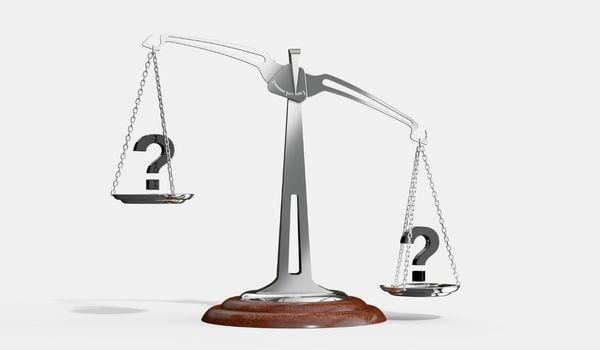
👍 What You’ll Love:
- Pristine Water Quality: Enjoy safe, great-tasting water from every tap — not just the kitchen sink.
- Whole-Home Coverage: These systems reduce chlorine, VOCs, and other toxins throughout your entire plumbing system.
- Less Sediment Buildup: Filters help trap sand, rust, and other particles that would otherwise clog fixtures and shorten appliance life.
- Long-Term Savings: While the upfront cost is higher, it can reduce bottled water expenses and faucet filter clutter over time.
⚠️ What to Be Aware Of:
- Ongoing Maintenance: Most systems need filter changes every 6–12 months. Missing a swap = performance drop.
- Higher Upfront Costs: Between purchase and installation, expect to invest $1,000–$3,500+ depending on the system.
- Not a Cure-All: Even the best filters won’t remove everything — always match the filter to your specific water report.
🧠 Expert Insight: Whole house filters are often used to reduce chlorine, sediment, or contaminants linked to aging pipes. But they aren’t always necessary. If your main concern is taste or minor odor, a smaller under-sink filter may be sufficient. The right fit depends on your water source, test results, and what you actually need to remove.
🚿 Installation & Long-Term Maintenance
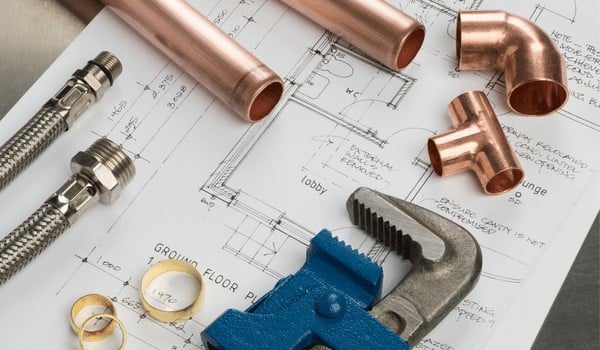
Installing a whole house filter system doesn’t need to be intimidating — especially if you follow a clear checklist and know what to expect for upkeep. Here’s a practical breakdown.
🧰 Installation Steps
- Preparation: Turn off your home’s main water supply. Choose a location near the main water line with easy access for future maintenance.
- Valve Installation: Install shut-off valves on both sides of the system. This lets you isolate the unit during servicing.
- Tubing Connections: Attach flexible tubing to each shut-off valve, making sure all connections are leak-proof.
- System Integration: Connect the outlet tubing to a T-fitting, which links back into your main water line.
- Drainage Setup: From the T-fitting, run tubing to a drain via an additional shut-off valve. This handles unfiltered water discharge.
- Cartridge Insertion: Install filter cartridges into the housing. Check for snug fit and ensure all seals are tight.
- System Activation: Restore your water supply. Look for leaks and verify flow rate and pressure.
- Enjoy: Once everything checks out, open the shut-off valves. Your home is now fully filtered!
🧠 Expert Tip: Install near a main water shutoff and drain line to simplify maintenance. It’ll save you time during future cartridge swaps or system flushes.
💬 “When I installed mine, pre-mounting the filter housing on a plywood board saved me hours. It kept everything aligned and made future filter changes way easier.”
🔧 Maintenance Tips for Optimal Performance
Tank-based units are generally low-maintenance. Cartridge systems, however, require more frequent check-ins. Use this checklist to keep your system running smoothly:
- Filter Replacement: Every 3–6 months (or per manufacturer), replace filters based on water quality.
- Housing Cleanliness: Rinse the housing unit when changing filters to prevent buildup.
- System Inspection: Regularly check for tight fittings and signs of corrosion or wear.
- Pressure Checks: Annually verify incoming pressure is between 40–60 psi. Too high or low? Time to troubleshoot.
- Sediment Flushing: Flush out sediment every 6 months using a drain valve or hose bib to clear clogs.
- Leak Surveillance: Monitor system joints and valves. Even small drips deserve immediate attention.
- Water Quality Monitoring: Test your water yearly to ensure the filter is working as expected and nothing’s slipping through.
💬 “I noticed water pressure started to dip around the 6-month mark. Swapping the sediment filter fixed it instantly — now I just mark it on my calendar.”
❓Still Deciding? Here’s What to Know
If your main concern is taste, an under-sink or pitcher filter may be enough. But for chlorine in showers, sediment buildup in pipes, or protecting your appliances, a whole house system is the better long-term fix.
Tank systems (like the SpringWell CF) use catalytic media and last 1,000,000 gallons with no flow drop. Cartridge filters (like Kind E-1000) require more frequent swaps but cost less upfront.
SpringWell CF and SoftPro Carbon excel at chlorine, chloramine, and VOCs. If you want fluoride or heavy metals removed too, consider the SoftPro or Aquasana EQ with upgraded media.
Sediment filters (iSpring) usually last 6 months. Tank systems last up to 10 years. Carbon cartridges like those in Kind E-1000 should be replaced every 6–12 months depending on usage.
Some systems like the Kind E-1000 are easy to DIY with basic plumbing skills, while others (like tank-based SpringWell or Aquasana systems) are better handled by a licensed plumber due to size, bypass valve setup, or pressure concerns.
Most whole house filters don’t soften water. They’re built to reduce chlorine, sediment, and VOCs — not minerals like calcium and magnesium. If you have hard water, you’ll need a water softener or a salt-free conditioner alongside your filter.
 158 people found this helpful. Was this guide helpful to you?
158 people found this helpful. Was this guide helpful to you? 

